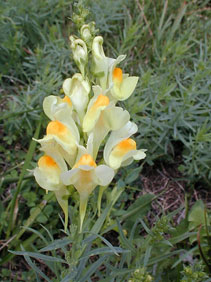YELLOW TOADFLAX
|
 |
| File Size: 90 KB |
|
|
|
Linaria vulgaris P. Mill.
|
| Riley County, Kansas |
| Perennial |
| Height: 12-30 inches |
| Family: Scrophulariaceae - Figwort Family |
| Flowering Period: June, July, August |
|
| Also Called: | | Butter-and-eggs, wild snapdragon. | | Stems: | | Erect or ascending, 1 to several, simple to branched. | | Leaves: | | Alternate or nearly opposite below, numerous, crowded, linear, 1 to 2 inches long, 1/12 to 1/4 inch wide, pale green, glabrous, narrowed to a stalk-like base. | | Inflorescences: | | Raceme, congested, spike-like, terminal; bracts alternate, reduced. | | Flowers: | | Short-stalked, calyx deeply 5-parted; segments lanceolate, nearly equal; corolla .8 to 1.6 inch long including spur, 2-lipped, bright yellow with orange beard on lower lip at throat; upper lip 2-lobed, 1/3 to 1/2 inch long; lower lip 3-lobed, 1/4 to 1/3 inch long; stamens 4. | | Fruits: | | Capsule, nearly spherical, 1/5 to 1/3 inch long, 2-celled; seeds numerous, disc-shaped with wings. | | Habitat: | | Open disturbed sites, roadsides, waste areas, and rangeland. | | Distribution: | | Scattered throughout Kansas | | Origin: | | Native of Europe and Asia. Introduced as an ornamental in North America in the 1800's and now naturalized. | | Toxicity: | | Suspected to be mildly poisonous to livestock. | | Comments: | | Strong-scented. Sometimes grown in flower gardens, but can escape and spread aggressively. In rangeland, it can displace desirable grasses. Yellow toadflax is difficult to eradicate, due to its extensive root system. |
|
| Yellow toadflax linflorescence |  | | 81 KB | | Riley County, Kansas |
| | Yellow toadflax leaves |  | | 116 KB | | Riley County, Kansas |
| | Yellow toadflax |  | | 163 KB | | Riley County, Kansas |
| | |
|
|
|
|
|
|